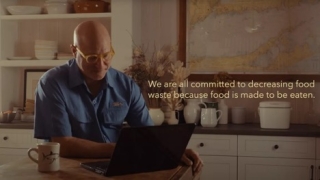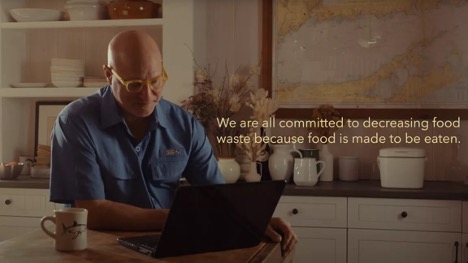
The Food Donation Improvement Act: A Guide for Culinary Educators
01 October 2024New act expands liability protections for food donors and encourages food businesses – including schools and non-profit organizations – to donate.
By Anya Obrez, Natural Resources Defense Council and Dr. Jonathan Deutsch, Drexel University
Feedback & comments: This email address is being protected from spambots. You need JavaScript enabled to view it.
As a country, we throw away a staggering amount of food—up to 40% of all the food grown and imported in the US is wasted. This waste is not limited to household kitchens; it permeates commercial and educational kitchens, where over-produced food, fruit and vegetable trimmings, and excess perishable inventory often go uneaten. In dining areas, there is often substantial plate waste as well as uneaten food from buffets and banquet stations (think large cheese, charcuterie or raw bar displays) that cannot be repurposed.
According to ReFED, if we rescue and redistribute this surplus food, we could potentially redirect an additional 2.3 million tons of food annually to individuals (about one in eight Americans experience food insecurity and hunger) while generating a net financial benefit of nearly $9 billion.
So why isn’t more food donated? There are a variety of reasons including lack of time, lack of knowledge, lack of storage, and logistical and transportation hurdles. However, one of the most pervasive myths preventing donation of food is the belief that donors will be subject to legal liability if the donated food were to inadvertently result in foodborne illness. If food donation is done properly and in good faith, the liability issue is not a concern.
The Food Donation Improvement Act (FDIA) is pivotal in supporting food rescue and redistribution by providing expanded liability protections for food donors and encouraging food businesses, including schools and non-profit organizations, to donate. As culinary educators, it is important to be aware of this legislation to help establish or further expand food rescue programs in your schools and communities.
Understanding the Food Donation Improvement Act
In January 2023, President Biden signed the bipartisan Food Donation Improvement Act (FDIA) into law. The law expands liability protections to donors and builds upon the Bill Emerson Good Samaritan Food Donation Act of 1996, which established liability protections for people who donated wholesome food to 501(c)3 nonprofits in good faith, provided they followed appropriate health and safety protocols. The FDIA further strengthens these protections, ensuring that donors who handle food in accordance with food safety laws and with the intent to help people cannot be held liable for civil or criminal charges if someone receiving the donated food were to get sick–or claim to have gotten sick–and file a lawsuit.
Key Updates of the Act
The FDIA updates the Bill Emerson Good Samaritan Act and the liability protections provided to food donors in two important ways:
- Liability protections now cover qualified direct donors (schools, restaurants, caterers, grocery stores, farmers, etc.) who donate good food directly to people. Previously, liability protections were only afforded to qualified donors if they donated the food to a 501(c)3 organization such as a soup kitchen, shelter or food pantry.
- Liability protections now cover nonprofit organizations and others that provide donated food products at a low price (an amount that covers the cost of handling, administering and distributing the food).
This act effectively enables food businesses, restaurants, schools and nonprofits to donate directly to their communities without the fear of liability. It also extends protections to food donated at a “Good Samaritan price,” defined as a price not exceeding the cost of handling and distributing the food. This creates opportunities for innovative food delivery models and broadens protections for social supermarkets and community kitchens who could offer foods at a discounted price to the community.
Food Donation Videos
Chef Tom Colicchio explains the importance of food donationin the Food is Made to be Eaten Video Series.
Credit: NRDC & McKenna Media (click to view video)
To raise awareness on this piece of legislation, NRDC created a series of short informational videos featuring Chef Tom Colicchio. These videos, along with additional resources such as the donor’s guide to enhanced federal tax donations, can be accessed here. We encourage educators and food donors to use these materials to educate their students and local communities. These materials can also be useful tools in educating administrators such as deans, principals, school boards, and general counsel, who may have decades-old misperceptions about the liability risk of donating surplus food. Establishing a food donation program for a campus or food business is an invaluable way to implement the recent updates and take action on redirecting surplus food from your kitchen.
Building a Food Donation Program in Your School: An Example from the Field
At Drexel University, where we have teaching kitchens for students studying culinary arts and science, food science, nutrition science and hospitality management, we strive to be “zero waste.” Practices include allowing students, many of whom experience food insecurity themselves, to take food home; donating leftovers and overproduction to community fridges or a nearby shelter; donating surplus product to our campus food pantry; and offering coursework in sustainable cooking, where students learn to use scraps and surplus product through a variety of food preservation and processing techniques that both preserve nutrition and build opportunities for flavor and skills development.
Conclusion
The Food Donation Improvement Act is an important step in supporting food donation by expanding liability protections, allowing us to reshape the narrative of food recovery in our kitchens and communities. According to ReFED, by educating potential food donors on liability laws, we have the potential to divert 57,000 tons of safe, surplus food from landfills annually. As culinary educators, educating ourselves so that we can then promote and teach principles of FDIA while fostering a culture of food donation will help cultivate a new generation of culinary professionals supporting the community and prioritizing a more sustainable future.
